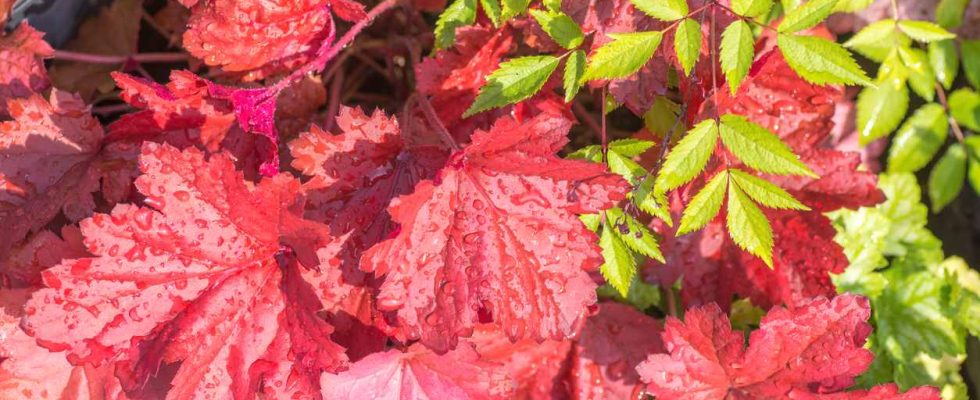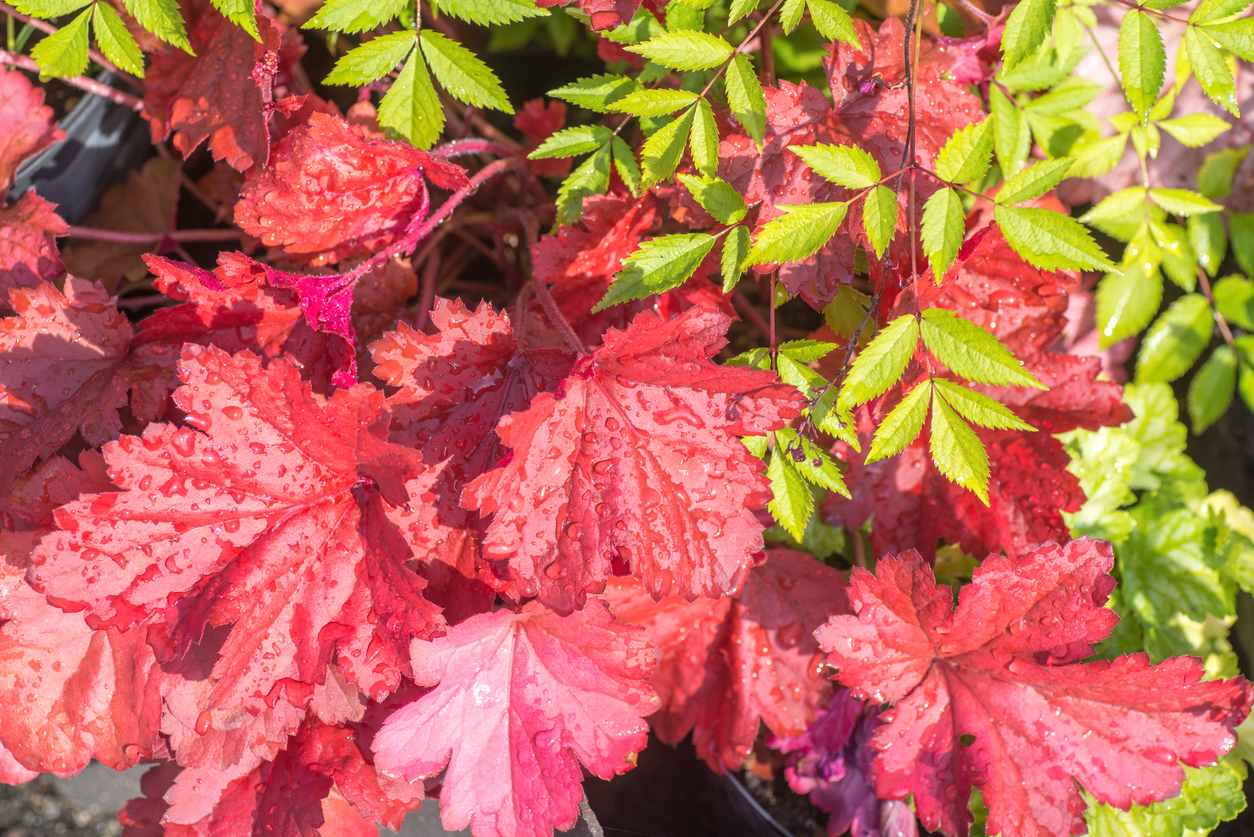
Plants with colorful foliage
While yesterday’s heucheras were mainly cultivated for their flowers (they were even cultivated as cut flowers in England between the wars), those of today are mainly renowned for their their colorful foliage. Certainly, they still flower, but this character has become secondary. Unlike old varieties, which are attractive for just a few weeks in spring, the new varieties are almost all interesting thanks to their evergreen foliage.
Traditionally, heucheres were border plants which hemmed the rows of the vegetable garden or outlined the edges of the flowerbeds. Their modernity now allows them to be used in a more original way, in the company of other perennials, shrubs or rose bushes, but also in more contemporary compositions which play on the diversity of their colors.
The Heucheres: a family… large!
It exists around twenty species of heuchera, mostly of North American origin. There, they grow in quite different places, from the semi-desert regions of Mexico to the slopes of the Rocky Mountains. Some fear rain, others need humidity to properly develop their foliage. Some spread out in beautiful colonies, others form tight clumps all their lives…
In recent years, there have been so many crosses that it is now quite difficult to know which species “descends” from this or that variety. How then can we find the ones best suited to the use and destination for which we intend them? How can we know their merits and faults? By trying them!
Variety guide and tips for sustainable growing
Since the appearance on the market of ‘Palace Purple’the first purple-leaved heuchera (and still one of the best) in the late 80s, more than 250 varieties were selected and recorded.
Every year, new selections join the ranks, but unfortunately, novelty and selection do not always rhyme with improvement. The “defect” that many gardeners blame heucheras is their lack of durabilitywhich undoubtedly comes from the genes of H. sangumea.
This species brought red or dark pink color leaves, but it does not tolerate humidity. H.americana offered its silvery mottling and a clear preference for shade, which makes its descendants rather susceptible as soon as they are planted in a situation that is too hot and too dry.
How to choose the right heucheres?
So far, only hybrids of Hachera Villosa And H. vilosa var. macrantharecognizable by their large hairy leaves, seem best adapted to extreme conditions of heat, humidity and cold.
They also turn out perfectly vivaciousdeveloping for several years in the same place without requiring the divisions and supply of food generally recommended for old heucheras.
To facilitate your choices, we have chosen to group together the varieties of heucheras most commonly available today in sorting them by color and detailing our impressions after trying them.
Where to install them?
The longest-lasting heucheras bring incredible purple or copper foliage to part-shaded spots. And unlike hostas, which enjoy their company, they do not attract slugs. Varieties with yellow or copper leaves are magnificent with ferns and shade grasses (sesleria, melica, sedges, etc.).
Even if recent varieties are appreciated for their colorful foliage, their small, light flowers, worn in vaporous bouquets, lighten the scenes in which they are included. Install them at the front of the flowerbeds, at the edge, with more classic plants (carnations, perennial geraniums, etc.).
How to grow heucheras in pots?
No need for a garden to have heucheras: they thrive in pots and can complement winter and spring decors – combined with heather and small flower bulbs – like summer arrangements, with begonias ‘Bonfire’cannas ‘Tropicanna’ or phormiums. They will always find a place in your color combinations!
Speaking of colors, you will quickly observe that the ideal companions of heucheras are plants with blue leaves or flowers, a color that does not exist in their range. Pair them with bellflowers, hostas, blue fescues and false oats (Helictotrichon sempervirens). And don’t hesitate to bring together the most vigorous (H. Villosa and its hybrids, for example) hydrangeas and hydrangeas, which appreciate the same environments.
Heucheres: succeed in their cultivation
1. A thoughtful purchase
You will find heucheras everywhere. In garden centers, seasonal plants department, they are generally not identified: use them for seasonal decor. In the perennial plants section, a few so-called common varieties are available in pots or small containers. The latter are more advantageous, but check for the absence of othiorrhynks at the base of the pots. For specific varieties, contact a perennial plant specialist.
2. A very simple planting
If you have chosen it carefully, your heuchera is free from earworm. This weevil betrays its presence by holes on the edges of the leaves, but its larvae (large whitish maggots) cause serious damage by devouring the roots. It is often introduced into peaty soils, and lives curled up at the bottom of the pot. This is why it is important to buy “year-old” plants (the larvae develop mainly in the pots that remain outside in winter).
Leave the root ball to soak for 10 minutes in a bucket of water. Loosen the roots and plant by mixing 3 handfuls of potting soil with the original soil. Lightly bury the base of the rhizomes, those thick “stems” that spread across the ground.
3. Easy multiplication
In spring or late summer, cut the rhizomes at their base. Remove all their leaves, except the last one, and stick them in a mixture of peat and sand: they will be rooted in less than two weeks.
During this time, new shoots will appear when the rhizome is cut; your original plant will thus be regenerated.
What do heucheras love?
- Loose soil.
- A fine mulch (crushed branches).
- Pebbles in and above the ground.
What do heucheras hate?
- Very hot situations.
- The proximity of more vigorous perennials
- Sandy soils, very poor.
Our selection of the 7 most beautiful varieties of heucheras
From ‘Obsidian’, the deep black heuchera, to the delicate pink-hued ‘Magic Wand’, these varieties bring a profusion of colors and shapes to satisfy every garden lover. Heucheras, with their shades varying from flamboyant red to purple brown, and their foliage ranging from bright blond to subtle variegation, offer an unrivaled palette for plant compositions full of contrasts and finesse. Immerse yourself in this universe where each heuchera tells a unique story, ideal for pots, low walls, or even sunny or semi-shaded rockeries.
1. Deep black
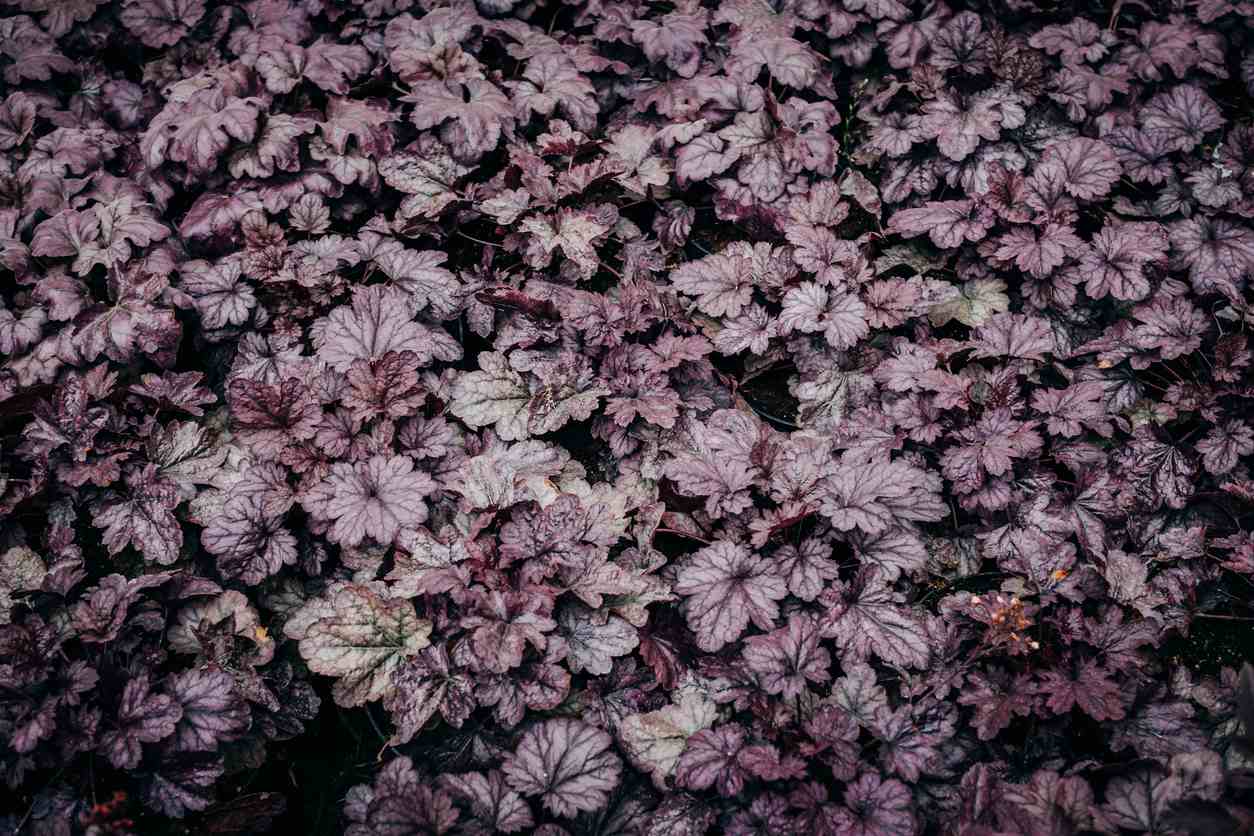

Long remained the blackest heuchera‘Obsidian‘ is today followed by the vigorous ‘Mocha’with larger leaves. ‘Blackout’ appears even darker, but its longevity has not yet been proven.
2. Flamboyant redhead
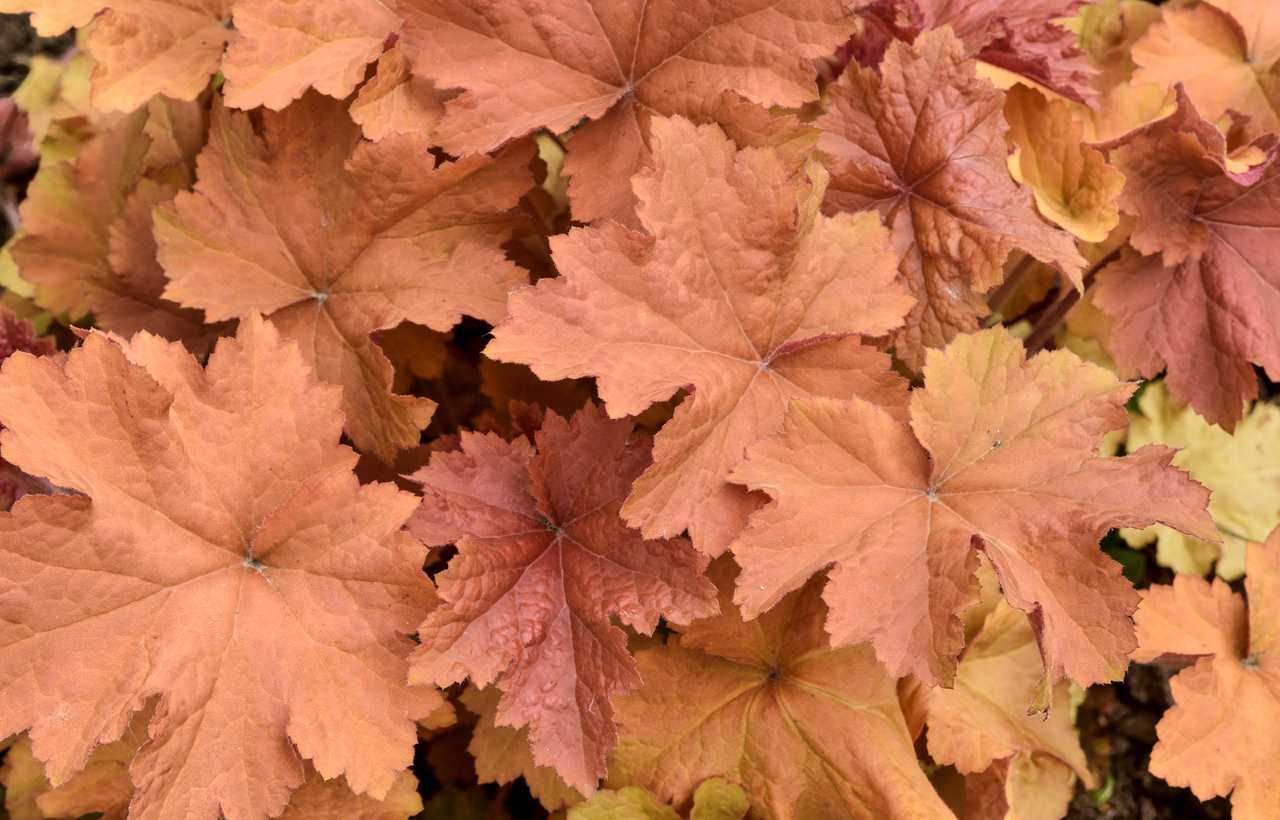

‘Amber Wave’ was the first, quickly dethroned by ‘Caramel’, the best in this category for the garden. with ‘Christa’a little darker. ‘Creme brulee’ And ‘Marmalade’ offer the same shades, but should be considered as seasonal plants, for pots and planters.
3. Purple Brown
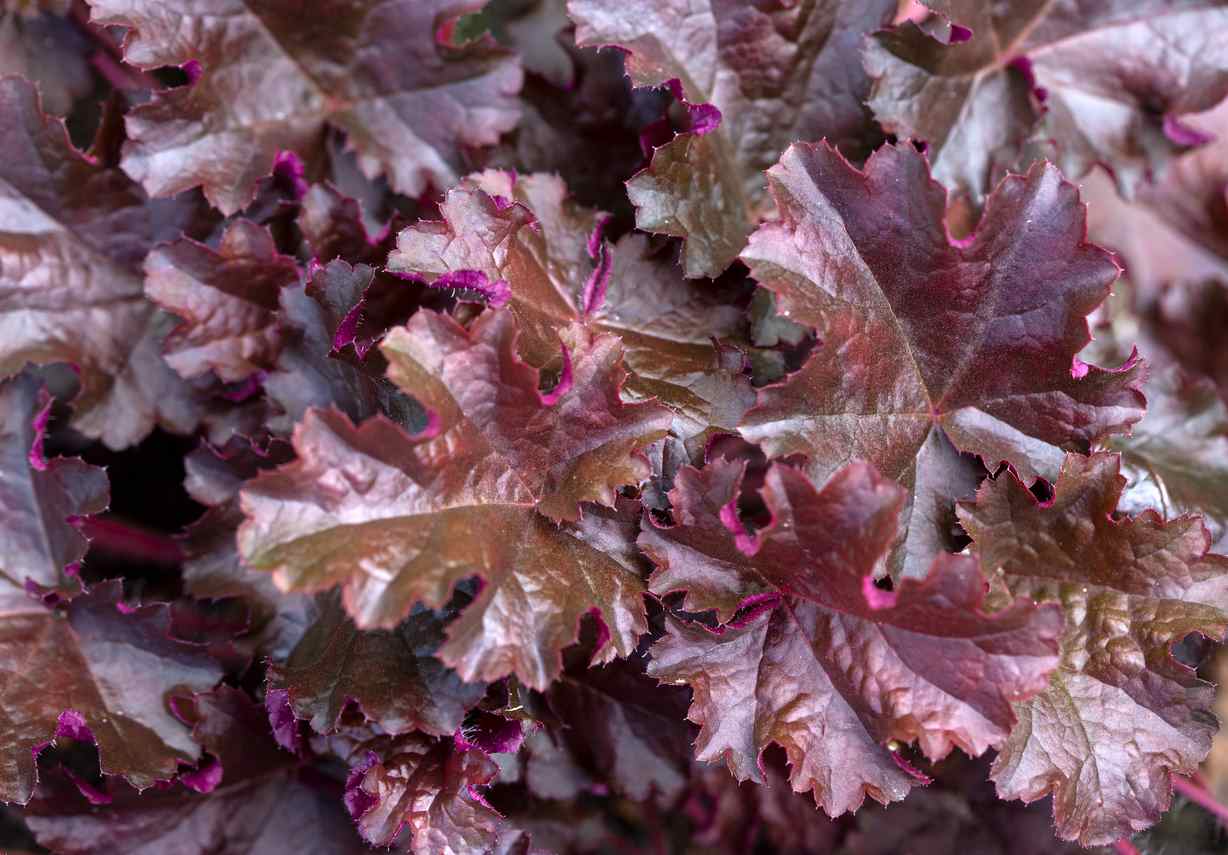

From ‘Palace Purple’ And ‘Rachel’many purple heucheras have succeeded one another, including the magnificent ‘Ebony and Ivory’ with white flowers or ‘Fireworks’ with bright pink flowers. ‘Pinot Noir’, ‘Pinot Gris’ And ‘Again’ bring different shades, especially the last one, silvery pink.
4. Bright blonde
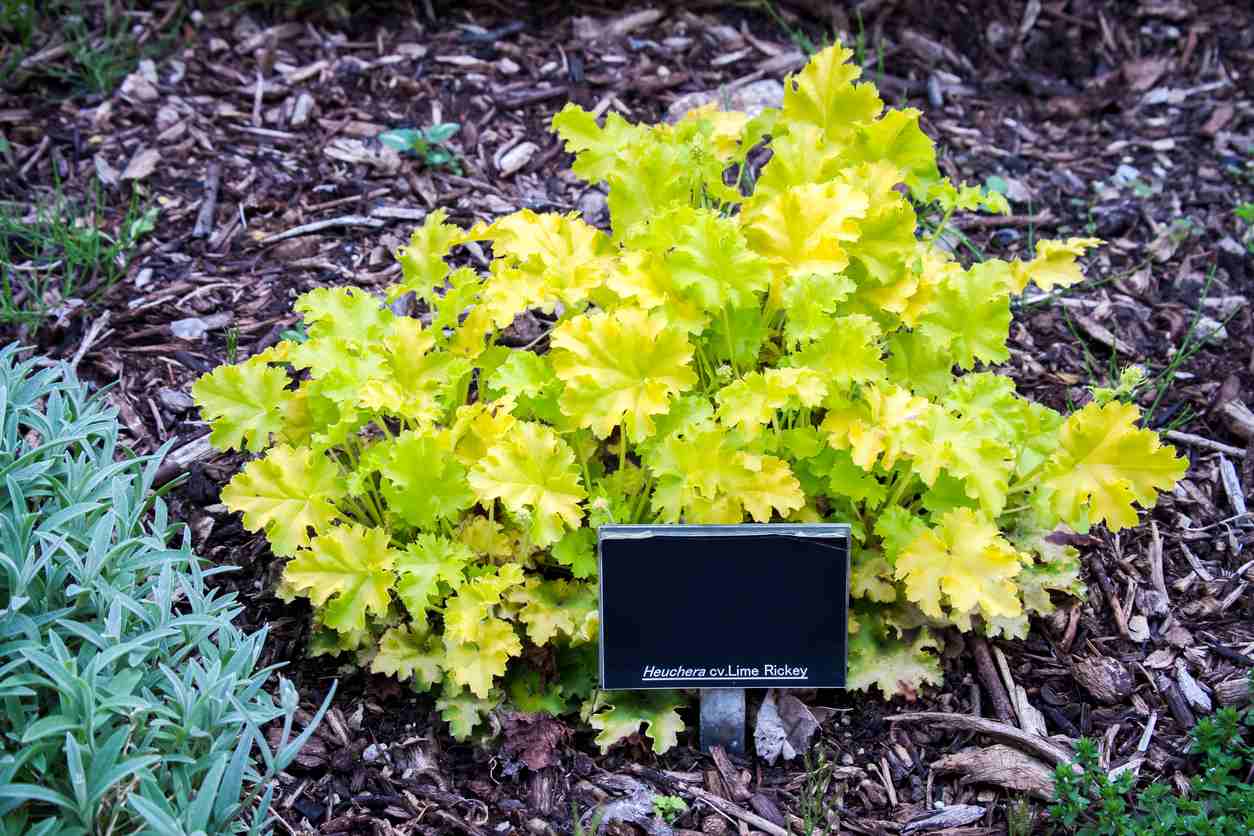

‘Lime Rickey’ inaugurated the yellow leaves range. More or less curly, they are green-yellow in summer, yellow-blond in winter and spring. Those of ‘Citronella’ and of ‘Pistachio’ (greener) are larger and more vigorous. Except for the last mentioned, they fear full sun.
5. Subtle variegation


‘Snowstorm’ is the latest shandy marketed on a large scale. Its almost white foliage contrasts with its red flowers, but it is not very vigorous and only does well in a pot. ‘Helen Dillon’a selection with large leaves spotted with cream, is more vigorous but also more difficult to find…
6. Sleek Curly


‘Cancan’ And ‘Chocolate Ruffle’the first curly heuchera with colored leaves, remain sure values. ‘Crimson Curls’ is more common today. All these heucheras are among the most durable and perennial, but their flowering is not very interesting.
7. Delicate bloom


‘Glory of Orléans’ is classic in old gardens. Its flowers are pink and its foliage is marbled with silver. It is still easy to find ‘Rain of Fire’the reddest cultivar, but also the most fragile, only survives through regular multiplication. ‘Green Ivory’more durable, can be recognized by its tight ears. ‘Magic Wand’ looks like him, but in pink.
The cousins of the heucheres
Tiarellas
They appreciate the shade of trees and flower in white or soft pink in May-June. Some are good ground covers.
The telumas
They look like hairy heucheras, with thicker leaves and green-yellow flowers. Evergreen and adapted to shade, certain varieties turn red in winter (‘Purpurteppich’).
Heucherellas
They come from the cross between heuchères and tiarelles. There are varieties with colorful foliage including ‘Stopligh’spectacular.
The tolmiéas
They are recognized by the small plants that grow spontaneously at the base of the leaves. Often sold as houseplants, they are hardy and can form large mats under trees.
Beware of imitations…
The heuchera market arouses the desire of laboratories which multiply them in vitro on a large scale. Everyone therefore strives to find plants of similar colors to the “best sellers” of its competitors, even if it means giving them names that are close enough to add to the confusion.
Thus, after the success of ‘Caramel’, we saw ‘Crème Brûlée’ and ‘Marmalade’, in identical colors. All this would only be a quarrel between competitors if the qualities of these varieties were not so different: if ‘Caramel’ is perennial, rustic and durable, the same is not true for the other two, which die in 2 or 3 years.

